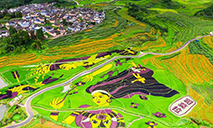Water outflow of China's Sanjiangyuan on the rise

Aerial photo taken on May 25, 2021 shows a view of Ngoring Lake in the Sanjiangyuan National Park in Golog Tibetan Autonomous Prefecture of northwest China's Qinghai Province. (Xinhua/Li Zhanyi)
XINING, Aug. 25 (Xinhua) -- Affected by climate warming and humidification, the amount of water flowing out of the Sanjiangyuan area, dubbed "Asia's water tower," has increased in recent years.
The amount of water outflowing from Qinghai Province, where Sanjiangyuan is located, reached 95.5 billion cubic meters in 2020, an increase of around 46.4 billion cubic meters compared with 2016.
The Sanjiangyuan (Three-River-Source) area is home to the headwaters of three major rivers -- the Yangtze River, China's longest; the Yellow River, the second-longest in the country; and the Lancang River (known as the Mekong River after it flows out of China).

Landforms of the Sanjiangyuan are seen in Madoi County, Golog Tibetan Autonomous Prefecture, northwest China's Qinghai Province, Oct. 30, 2020.(Xinhua/Zhang Long)
"Under the background of global warming, the natural environment and hydrological regime in the Sanjiangyuan area are changing," said Li Yan, a member of a research team on the Yangtze River and an official with the hydrology and water resources measuring and reporting center of Qinghai.
A series of research into the run-off in Qinghai showed the increase in the amount of water flowing out of Sanjiangyuan was due to growing precipitation and melting glaciers, Li said.
Li said that the increasing outflow from the Sanjiangyuan can provide basic conditions for the construction of water supply and water diversion projects and can also benefit residents in the downstream provinces.
"However, further research on glacier degradation and permafrost melting should be conducted to grasp the changing of the outflow in the medium and long term."
MORE LAKES
Research data showed more than 11,000 lakes distributed in the headwaters area of the Yangtze River covered a total area of 1,027 square km, which is the largest and highest plateau lake cluster globally.
"Recent research indicated that the water quality of lakes around the headwaters of the Yangtze River remains good. The area of lakes and wetlands in the region increased by 7.2 percent over the past four decades," said Xu Ping, deputy chief engineer with Changjiang River Scientific Research Institute.

Aerial photo taken on Oct. 30, 2020 shows a wetland in Madoi County, Golog Tibetan Autonomous Prefecture, northwest China's Qinghai Province.(Xinhua/Zhang Long)
The headwaters area of the Yangtze River is getting warmer and more humid. The average temperature and precipitation over the past ten years have increased by 1.4 degrees Celsius and 39.6 mm, respectively, compared with the average figures over the previous 40 years, according to research data.
Glacier degradation and permafrost melting, triggered by rising temperatures and increased precipitation, also accelerated the expansion of the lake area, Xu said.

A Tibetan antelope is seen at the source of the Yellow River section of the Sanjiangyuan National Park in Golog Tibetan Autonomous Prefecture of northwest China's Qinghai Province, May 25, 2021. (Xinhua/Zhang Long)
"Although lakes and wetlands can regulate and control the outflow of rivers' headwaters and the regional climate, and provide important habitats for diversified creatures, the increased lake area, and rising water levels will have adverse impacts on the ecosystem around the lakes and nearby infrastructure," said Tan Debao, deputy chief engineer with Changjiang River Scientific Research Institute.
Much attention should be given to studies of the increased area of lakes and rising water levels to protect the ecosystem in the headwaters region, Tan added.
Photos
 Dance show saluting traditional culture of the Song Dynasty makes its debut
Dance show saluting traditional culture of the Song Dynasty makes its debut Village in SW China’s Yunnan embraces prosperity through agricultural tourism
Village in SW China’s Yunnan embraces prosperity through agricultural tourism Eighth birthday for pair of giant pandas celebrated in Haikou, Hainan province
Eighth birthday for pair of giant pandas celebrated in Haikou, Hainan province Olympic gold medalists portrayed in Shanxi artist’s polymer clay sculptures
Olympic gold medalists portrayed in Shanxi artist’s polymer clay sculptures
Related Stories
- Water outflow of China's Sanjiangyuan on the rise
- New potential astronomical observation site identified on Qinghai-Tibet Plateau
- Rigs to be used to rescue trapped mine workers in China's Qinghai
- Xining strives to build itself into a city of happiness
- China sends work team to guide rescue after mine flooding in Qinghai Province
Copyright © 2021 People's Daily Online. All Rights Reserved.






